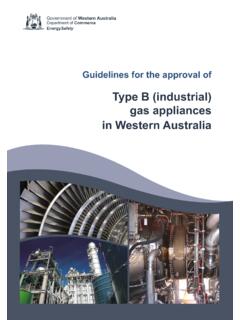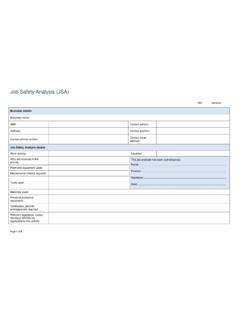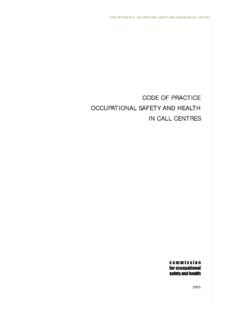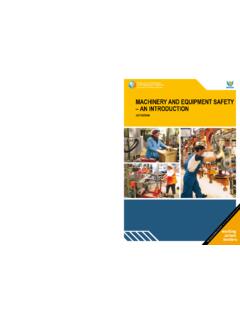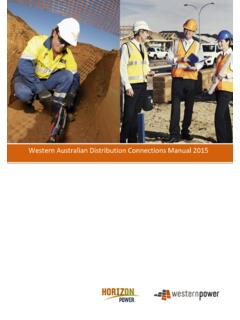Transcription of Guidelines for HV Installations - Department of Commerce
1 Government of western AustraliaDepartment of CommerceEnergySafetyGuidelines for theSafe management of high voltage electrical installationsApril 20142 Safe management of high voltage electrical installationsSafe management of high voltage electrical Installations 3 PrefaceThese Guidelines for the safe management of high voltage electrical Installations are issued under Section 33AA of the Electricity Act 1945 (WA) by the Director of Energy Safety and are endorsed by risks and potential consequences of an electrical incident involving high voltage are significantly higher than low voltage due to the much higher quantities of energy involved. This justifies stringent safety designs and operating procedures to prevent injury to persons and major damage to electrical Installations and strongly recommend compliance with the practices and procedures set out in these Guidelines .
2 Should you have any suggestions and comments on these Guidelines , please send them to me in writing and I will be pleased to consider BowronDIRECTOR OF ENERGY SAFETYENDORSED:Lex McCullochWORKSAFE COMMISSIONER2 Safe management of high voltage electrical installationsSafe management of high voltage electrical Installations 3 ContentsPreface 2 Summary 41. Introduction Duty of Care Electrical Risks Definitions Application 62. Design and Construction General Technical Requirements Submission of HV Design Proposal HV Submission outline Commissioning Tests 83.
3 Maintenance 94. Operation HV Operating Procedures & Safety management Plan High Voltage Switching Operators Switching Agreement Basic Safety Requirements 135. Audits 154 Safe management of high voltage electrical installationsSafe management of high voltage electrical Installations 5 Summary The responsible persons for premises with high voltage (HV) electrical Installations are required to comply with all relevant technical and safety requirements for the duration of the operating life of the electrical plant, including: design and construction; maintenance; and operation.
4 These Guidelines complement, and should be read together with, other related documents including (but not limited to): Electricity (Licensing) Regulations 1991 The WA Electrical Requirements Network operators technical rules Relevant technical standards Occupational Safety and Health Act 1984 Occupational Safety and Health Regulations 1996 The western australian Distribution Connections Manual Technical requirements for design purposes are covered by legislation and technical standards and are not repeated in these Guidelines . Design proposals for all Installations connected to a network at voltages greater than 1kV are required to be submitted to the network operator for assessment ( HV submission ).
5 A comprehensive electrical safety management plan and safe working procedures should be developed and maintained for all HV Safe management of high voltage electrical installationsSafe management of high voltage electrical Installations 51. Duty of CareThe owners of premises or persons having control of a workplace (see definition of responsible person below) are responsible for the safety of people and property in relation to the management and conduct of undertakings at those Electrical RisksThe most common risks of death or injury caused directly or indirectly by electricity are: electric shock; arcing, explosion or fire; and ingestion of toxic materials released by burning and arcing associated with electrical equipment.
6 Electric shocks from faulty electrical equipment may also lead to related injuries, including falls from ladders, scaffolds or other elevated work platforms. Other injuries or illnesses may include muscle spasms, palpitations, nausea, vomiting, collapse and unconsciousness. The electrical risks and consequences of an electrical incident involving high voltage may be significantly higher than for low voltage. Under fault conditions, the higher voltages and fault current levels can release massive quantities of energy. The inherent risks are therefore potentially very high and must be effectively managed. Under occupational safety and health legislation, the responsible person has the primary duty to ensure, so far as is reasonably practicable, that workers and other persons at the workplace are not exposed to electrical risks.
7 This duty requires eliminating or minimising and managing these risks. These responsibilities include but are not limited to ensuring compliance with all relevant technical and safety requirements for the duration of the operating life of the electrical plant, including: design and construction; maintenance; and Guidelines complement, and should be read together with, other related documents including (but not limited to): Electricity (Licensing) Regulations 1991 WA Electrical Requirements ( WAER ) Network operators technical rules Relevant electrical technical standards Occupational Safety and Health Act 19846 Safe management of high voltage electrical installationsSafe management of high voltage electrical Installations 7 Occupational Safety and Health Regulations 1996 western australian Distribution Connections Manual ( WADCM )1 The fundamental requirements specified in Regulation 49 of the Electricity (Licensing) Regulations 1991 must be observed to ensure that HV Installations .
8 Are safe to use, maintain and operate, recognizing that higher voltages and related fault levelsare more dangerous, demanding additional attention to manage the risks to an acceptablelevel; and are suitable for connection to an electricity supply network, where this is DefinitionsFor the purposes of these Guidelines : high voltage means an operating voltage of 1kV and higher. network operator has the meaning given in the Electricity (Network Safety) Regulations 2015. responsible person is the person responsible for the ongoing safety of people and property in relation to the management and conduct of undertakings at those premises. The Occupational Safety and Health Act 1984 and the Occupational Safety and Health Regulations 1996 establish duties upon a number of persons in respect to workplaces.
9 Professionally qualified engineer has the meaning given in Part 3 of the Electricity (Licensing) Regulations ApplicationThese Guidelines do not apply to network operators HV Installations which are covered by the Electricity (Network Safety) Regulations produced by western Power and Horizon Power for connection to their distribution networks6 Safe management of high voltage electrical installationsSafe management of high voltage electrical Installations and GeneralHV electrical Installations (and subsequent major augmentations) must be designed and constructed to a standard consistent with good industry practice, with careful consideration of the ongoing safety of personnel and members of the public, integrity of equipment and risks to Technical RequirementsThe technical requirements for design purposes are adequately covered by various existing legislation and technical standards and are not repeated in this relevant documents include, but are not limited to.
10 WAER (published by EnergySafety) Network operators technical rules (published by network operators) Relevant electrical technical standards, including AS/NZS 2067, AS/NZS 3000 and AS/NZS7000 WADCM Other network operator connection requirementsSome HV Installations , such as those on mine sites, are also subject to special technical safety requirements administered by the Resources Safety Division of the Department of Mines and Submission of HV Design ProposalFor all proposed new HV Installations and subsequent material augmentations, the WAER requires a HV installation design proposal to be developed and certified by a professionally qualified engineer as complying with all relevant technical connection to a network is required.


